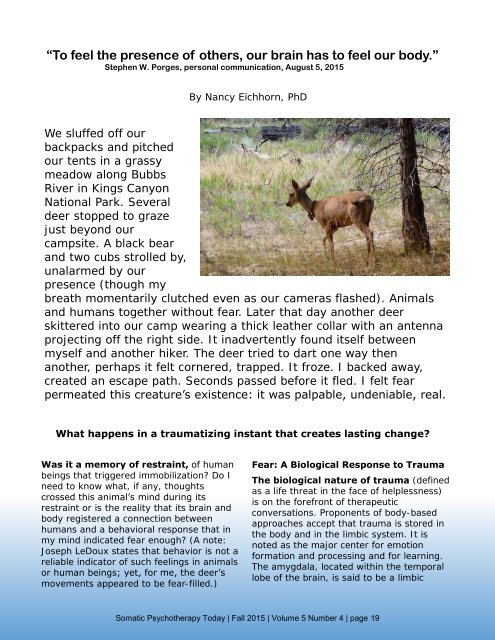Somatic Psychotherapy Today
1RCP3xp
1RCP3xp
Create successful ePaper yourself
Turn your PDF publications into a flip-book with our unique Google optimized e-Paper software.
“To feel the presence of others, our brain has to feel our body.”<br />
Stephen W. Porges, personal communication, August 5, 2015<br />
By Nancy Eichhorn, PhD<br />
We sluffed off our<br />
backpacks and pitched<br />
our tents in a grassy<br />
meadow along Bubbs<br />
River in Kings Canyon<br />
National Park. Several<br />
deer stopped to graze<br />
just beyond our<br />
campsite. A black bear<br />
and two cubs strolled by,<br />
unalarmed by our<br />
presence (though my<br />
breath momentarily clutched even as our cameras flashed). Animals<br />
and humans together without fear. Later that day another deer<br />
skittered into our camp wearing a thick leather collar with an antenna<br />
projecting off the right side. It inadvertently found itself between<br />
myself and another hiker. The deer tried to dart one way then<br />
another, perhaps it felt cornered, trapped. It froze. I backed away,<br />
created an escape path. Seconds passed before it fled. I felt fear<br />
permeated this creature’s existence: it was palpable, undeniable, real.<br />
What happens in a traumatizing instant that creates lasting change?<br />
Was it a memory of restraint, of human<br />
beings that triggered immobilization? Do I<br />
need to know what, if any, thoughts<br />
crossed this animal’s mind during its<br />
restraint or is the reality that its brain and<br />
body registered a connection between<br />
humans and a behavioral response that in<br />
my mind indicated fear enough? (A note:<br />
Joseph LeDoux states that behavior is not a<br />
reliable indicator of such feelings in animals<br />
or human beings; yet, for me, the deer’s<br />
movements appeared to be fear-filled.)<br />
Fear: A Biological Response to Trauma<br />
The biological nature of trauma (defined<br />
as a life threat in the face of helplessness)<br />
is on the forefront of therapeutic<br />
conversations. Proponents of body-based<br />
approaches accept that trauma is stored in<br />
the body and in the limbic system. It is<br />
noted as the major center for emotion<br />
formation and processing and for learning.<br />
The amygdala, located within the temporal<br />
lobe of the brain, is said to be a limbic<br />
<strong>Somatic</strong> <strong>Psychotherapy</strong> <strong>Today</strong> | Fall 2015 | Volume 5 Number 4 | page 19


